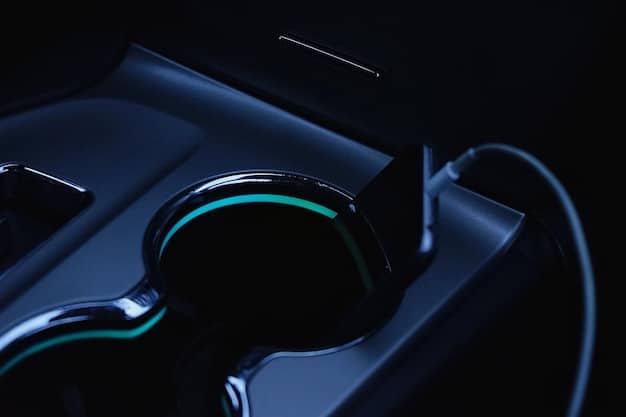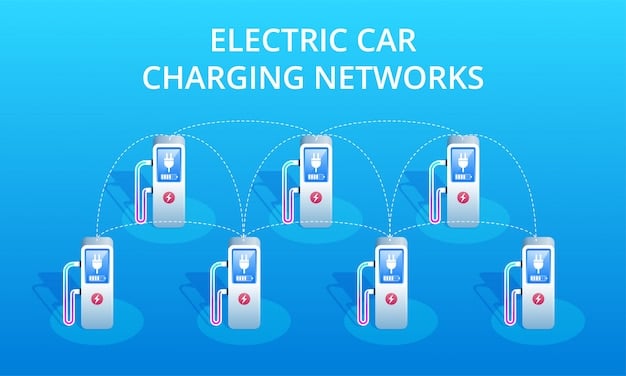Wireless EV Charging: The Next Revolution in Electric Vehicle Technology?

Wireless charging for electric vehicles is emerging as a transformative technology, offering convenience and efficiency that could redefine how EVs are powered in the future, making charging as simple as parking.
The world of electric vehicles (EVs) is constantly evolving, with innovations aimed at making them more convenient and efficient. One of the most promising advancements on the horizon is electric vehicle technology advancement: wireless charging for electric vehicles – is this the future of electric vehicle charging?
Understanding Wireless Charging Technology for EVs
Wireless charging, also known as inductive charging, uses electromagnetic fields to transfer energy between two objects. In the context of EVs, this means you can charge your car without needing to plug it in. Instead, you simply park your car over a charging pad, and energy is transferred wirelessly.
How Wireless Charging Works
The technology behind wireless EV charging involves two main components: a transmitting coil and a receiving coil. The transmitting coil is embedded in the charging pad, while the receiving coil is installed in the vehicle. When an alternating current passes through the transmitting coil, it creates a magnetic field. This field induces an electric current in the receiving coil, which then charges the EV’s battery.
Key Benefits of Wireless Charging
- Convenience: No more fumbling with cables in the dark or in bad weather. Simply park and charge.
- Aesthetics: Wireless charging eliminates the need for bulky charging stations and cables, creating a cleaner, more streamlined look.
- Accessibility: Wireless charging can be particularly beneficial for individuals with mobility issues, making EV ownership more accessible.
- Automation: Wireless charging can be integrated with autonomous parking systems, allowing vehicles to self-park and charge without human intervention.
Wireless charging represents a significant step forward in making EV ownership more convenient and user-friendly. Its potential to seamlessly integrate into our daily lives makes it a compelling technology for the future of electric mobility.

The Different Types of Wireless EV Charging
Wireless EV charging isn’t just a one-size-fits-all solution. There are different types, each with its own set of advantages and use cases. Understanding these variations is crucial for appreciating the full potential of this technology.
Static Wireless Charging
Static wireless charging is the most common type and involves charging the EV while it’s parked. This is ideal for home charging, parking lots, and public charging stations. The car needs to be precisely positioned over the charging pad for optimal energy transfer.
Dynamic Wireless Charging
Dynamic wireless charging, also known as in-motion charging, allows EVs to charge while driving. This is achieved by embedding charging pads in the road surface. As the EV drives over these pads, it receives a charge. This technology has the potential to significantly extend the range of EVs, as they can continuously charge while in use.
Semi-Dynamic Wireless Charging
Semi-dynamic wireless charging is a hybrid approach that combines elements of both static and dynamic charging. In this scenario, EVs can charge while briefly stopped, such as at traffic lights or during short stops. This can help maintain the battery level and reduce the need for frequent static charging sessions.
Each type of wireless charging offers a unique set of benefits, catering to different driving patterns and charging needs. As the technology matures, we can expect to see a combination of these approaches implemented to create a comprehensive wireless charging infrastructure.
The Advantages of Wireless EV Charging Over Traditional Methods
While traditional plug-in charging has served as the primary method for powering EVs, wireless charging presents several compelling advantages. These benefits extend beyond mere convenience, offering potential improvements in efficiency, cost, and infrastructure development.
Enhanced Convenience
The most immediate advantage of wireless charging is its ease of use. Drivers no longer need to deal with cables, connectors, or the hassle of plugging in. This is particularly beneficial in adverse weather conditions or for individuals with limited mobility.
Improved Aesthetics
Wireless charging eliminates the need for unsightly charging stations and tangled cables. This can lead to a cleaner, more visually appealing environment, especially in public spaces and residential areas.
Potential for Automation
Wireless charging can be seamlessly integrated with autonomous parking systems. EVs can automatically park over charging pads and initiate charging without any human intervention. This level of automation can significantly enhance the user experience and optimize energy management.
Reduced Infrastructure Costs
While the initial investment in wireless charging infrastructure may be higher, it can potentially reduce long-term costs. Wireless charging pads are less prone to wear and tear compared to traditional charging cables and connectors, leading to lower maintenance and replacement expenses.
The advantages of wireless charging extend beyond mere convenience, offering potential improvements in cost, efficiency, and the overall user experience. As the technology continues to evolve, it’s poised to become a mainstream charging solution for EVs.

Challenges and Limitations of Wireless EV Charging
Despite its numerous advantages, wireless charging for EVs faces several challenges and limitations that need to be addressed before it can achieve widespread adoption. These include technical hurdles, safety concerns, and infrastructure development issues.
Efficiency and Energy Loss
Wireless charging is generally less efficient than traditional plug-in charging due to energy loss during the wireless transfer process. Some energy is lost as heat in the transmitting and receiving coils. Improving the efficiency of wireless charging systems is crucial for maximizing energy utilization and minimizing waste.
Interoperability and Standardization
The lack of universal standards for wireless charging can create interoperability issues between different EVs and charging pads. Ensuring that all EVs can seamlessly charge on any wireless charging pad is essential for widespread adoption. Standardization efforts are underway to address this challenge.
Cost and Affordability
Wireless charging systems are currently more expensive than traditional plug-in chargers. Reducing the cost of wireless charging technology is crucial for making it accessible to a wider range of EV owners. As production volumes increase and technology matures, costs are expected to decline.
Safety Concerns
Wireless charging involves the transmission of electromagnetic fields, which raises potential safety concerns. Ensuring that these fields are within safe limits and do not pose any health risks is of utmost importance. Rigorous testing and adherence to safety standards are essential for addressing these concerns.
Addressing these challenges and limitations is crucial for realizing the full potential of wireless EV charging. Ongoing research and development efforts are focused on overcoming these hurdles and paving the way for widespread adoption.
The Future of Wireless EV Charging: What to Expect
The future of wireless EV charging looks promising, with ongoing advancements aimed at improving efficiency, reducing costs, and expanding infrastructure. Several key trends are expected to shape the evolution of this technology in the coming years.
Increased Efficiency
Researchers are actively working on improving the efficiency of wireless charging systems by optimizing coil design, using advanced materials, and implementing sophisticated control algorithms. These efforts are expected to significantly reduce energy loss and increase charging speed.
Standardization and Interoperability
Industry consortia and regulatory bodies are working to develop universal standards for wireless charging. These standards will ensure interoperability between different EVs and charging pads, making it easier for consumers to adopt wireless charging.
Integration with Smart Grids
Wireless charging can be integrated with smart grids to optimize energy distribution and reduce peak demand. Smart charging systems can automatically adjust charging rates based on grid conditions, helping to balance the electricity supply and demand.
Expansion of Charging Infrastructure
Governments and private companies are investing in the development of wireless charging infrastructure. This includes installing wireless charging pads in parking lots, public spaces, and even roadways. The expansion of charging infrastructure is crucial for increasing the adoption of EVs and promoting sustainable transportation.
The future of wireless EV charging is bright, with ongoing advancements and increasing investments paving the way for widespread adoption. As the technology matures, it’s poised to become an integral part of the EV ecosystem.
Real-World Applications and Pilot Projects
Wireless EV charging is no longer just a theoretical concept. Several real-world applications and pilot projects are underway around the globe, demonstrating the feasibility and potential of this technology. These initiatives are providing valuable insights and paving the way for commercial deployment.
Wireless Charging Buses
Several cities have implemented wireless charging systems for electric buses. These buses can wirelessly charge at bus stops while passengers are boarding and alighting. This allows the buses to operate for longer hours without needing to return to a central charging station.
Wireless Charging Taxis
Some cities are testing wireless charging systems for electric taxis. Taxis can wirelessly charge at designated charging spots while waiting for passengers. This can help maintain the battery level and reduce the need for frequent plug-in charging sessions.
Wireless Charging Parking Lots
Several parking lots are equipped with wireless charging pads. EV owners can simply park their cars over the charging pads and initiate charging without needing to plug in. This provides a convenient and hassle-free charging solution for EV owners.
Dynamic Wireless Charging Roads
Some countries are experimenting with dynamic wireless charging roads. These roads are embedded with charging pads that allow EVs to charge while driving. This technology has the potential to significantly extend the range of EVs and reduce the anxiety associated with range limitations.
These real-world applications and pilot projects are demonstrating the feasibility and potential of wireless EV charging. As the technology matures and becomes more cost-effective, we can expect to see more widespread deployment of wireless charging systems in various applications.
| Key Point | Brief Description |
|---|---|
| 💡 Convenience | No cables needed: park & charge easily. |
| 🛣️ Dynamic Charging | Charge while driving on equipped roads. |
| 💰 Cost Reduction | Potential savings in maintenance and infrastructure. |
| 🌍 Sustainability | Supports eco-friendly transportation. |
FAQ
▼
Wireless EV charging uses electromagnetic fields to transfer energy from a charging pad to a receiver in the vehicle. Simply park over the pad to begin charging.
▼
Currently, wireless charging is typically less efficient than plug-in charging. However, ongoing research aims to improve efficiency and reduce energy loss during the wireless transfer.
▼
Yes, safety standards are in place to ensure that electromagnetic fields are within safe limits. Rigorous testing and compliance with these standards are essential for wireless charging systems.
▼
Not all EVs are equipped for wireless charging. The vehicle must have a compatible receiver installed. As the technology becomes more common, more EV models are expected to support wireless charging.
▼
Dynamic wireless charging allows EVs to charge while driving, potentially extending their range. This can reduce range anxiety and the need for frequent stops at charging stations by maintaning its battery lever.
Conclusion
In conclusion, wireless charging technology holds immense promise for the future of electric vehicles. While challenges remain, ongoing advancements and increasing investments are paving the way for widespread adoption, offering a more convenient and efficient way to power our EVs.





